Alaska State Troopers
The Alaska State Troopers, officially the Division of Alaska State Troopers (AST), is the state police agency of the U.S. state of Alaska. It is a division of the Alaska Department of Public Safety (DPS). The AST is a full-service law enforcement agency that handles both traffic and criminal law enforcement. The AST is also involved in apprehending fugitives as part of the Alaska Fugitive Task Force, an inter-agency collaborative of Alaska police departments that cooperates with police agencies throughout the United States and less commonly with Interpol in apprehending wanted men and women. Unlike many lower 48 states, the AST also serves as Alaska’s primary environmental law enforcement agency; troopers assigned to the AST’s Division of Alaska Wildlife Troopers are known as "Alaska Wildlife Troopers" and primarily serve as game wardens, although they retain the same powers as other Alaskan state troopers.
| Division of Alaska State Troopers | |
|---|---|
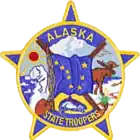 Patch of the Alaska State Troopers | |
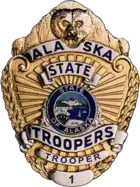 Badge of the Alaska State Troopers | |
 Flag of the Alaska State Troopers | |
| Common name | Alaska State Troopers |
| Abbreviation | AST |
| Motto | "Loyalty, Integrity, Courage" |
| Agency overview | |
| Formed | 1967 |
| Preceding agencies |
|
| Jurisdictional structure | |
| Operations jurisdiction | Alaska, U.S. |
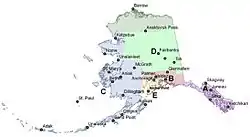 | |
| Alaska State Trooper Detachments | |
| Size | 663,268 square miles (1,717,900 km2) |
| Population | 736,556 (2022)[1] |
| General nature | |
| Operational structure | |
| Headquarters | Anchorage, Alaska |
| Troopers | 300[2] |
| Civilian members | 147 |
| Agency executive |
|
| Parent agency | Alaska Department of Public Safety |
| Bureaus | 2 |
| Detachments | 5 |
| Website | |
| https://dps.alaska.gov/AST/Home | |
Because Alaska has no counties, therefore no county police or sheriffs, in its constitution, the troopers also handle civil papers and mental health custody orders and serve as police through most of rural Alaska. Alaska does have boroughs, which have some similarities but with the lesser powers of lower-48 U.S. counties, but only the North Slope Borough Police Department truly functions similarly to a lower-48 county police agency, thus relieving AST of the need to be the primary police agency in this particular region. With jurisdiction across all 663,268 square miles (1,717,856 square kilometres) of Alaska, Alaskan state troopers are the most geographically extended law enforcement officers within the United States, apart from federal officers. They have little, if any, local backup. Within the entire State of Alaska, only about 1,300 full-time sworn law enforcement officers patrol a state 1/5th the size of the entire Lower 48. Other than troopers and state park rangers (peace officers employed by Alaska’s Division of Parks and Outdoor Recreation), local officers remain in their communities except in extreme emergencies. This includes the only metropolitan police agency in Alaska, the Anchorage Police Department,with almost 500 officers. The remaining officers are the over 300 Alaska troopers and smaller municipal agencies,which have around 50 in towns like the state capital of Juneau or the second largest town in the state, Fairbanks. The remaining full-time officers serve in small agencies with anywhere from one to ten officers on average. The Alaska State Troopers are assisted in their rural policing duties by Village Public Safety Officers (VPSOs). VPSOs are, as of 2014, fully sworn and armed peace officers who handle basic law enforcement in extremely remote and/or small Alaskan communities; Alaskan state troopers travel to these communities to assist VPSOs as needed.
The DPS is headed by a Commissioner appointed by the Governor. This person is a civilian administrator, though historically he was a career law enforcement officer and administrator. The Commissioner, if a sworn officer upon being appointed as such, may be appointed a "Special Alaska State Trooper" to maintain police powers. The Alaska State Troopers (AST) and Alaska Wildlife Troopers (AWT) are headed by ranking officers with the rank of Colonel.
History
The Alaska State Troopers trace their heritage back more than a century. Before its founding, law enforcement in Alaska was performed by a succession of federal agencies: the Army, Navy, and Revenue Cutter Service; the Customs Service; and the Marshals Service. After a civil government was formed in 1884,
The need for law enforcement became critical in the late 19th century as gold was discovered in Alaska. Gold rush towns had crime rates per capita that dwarfed those of modern U.S. cities. Prostitution, gambling, murder, rape, robbery, arson, kidnapping, aggravated assault, and claim jumping incidents were rampant. Frightened citizens desperately called for help. As a result, scores of deputy marshals were deployed to Alaska. Some cities and towns began to charter police departments in the early 20th century. Deputy marshals continued to be the main force of law in rural Alaska until the advent of the troopers, and many early-era officers of the agency were former deputy marshals.
There was no Alaska-wide police force until 1941, when the territorial legislature created the Alaska Highway Patrol. Territorial patrolmen only patrolled the main highways of Alaska and did not visit remote areas or regions. They were commissioned to only enforce traffic laws. They were eventually deputized as special deputy marshals to fill this void in jurisdiction. The legislature refused to make them police officers until the agency was changed to Territorial Police and additional personnel were hired from among the marshals' ranks. The new agency became the Alaska Territorial Police in 1953, the Alaska State Police in 1959 after Alaska became a State, and changed its title to Alaska State Troopers in 1967.
Duties
The Division of Alaska State Troopers personnel are the general police arm of the agency. They are charged with statewide law enforcement, prevention of crimes, pursuit and apprehension of offenders, service of civil and criminal process, prisoner transportation, central communications, and search and rescue. They perform traditional duties most closely associated with state police in the lower 48 states.
National security and post-9/11 roles
The Alaska State Troopers trace special duties back to the onset of World War II, when Territorial Highway Patrolmen watched for Japanese invaders and saboteurs by guarding and patrolling Alaska seaports, railroad tracks, airports, military posts and other important facilities. This was especially critical following the invasion of Alaska by the Japanese. Territorial patrolmen also assisted the military by arresting deserters and AWOLS from the armed forces.
After the 9-11 attacks, Alaska State Troopers were recognized by the US government as being in an extremely valuable and unique position and thus a critical asset to national security. Alaska is by distance close to a nuclear-armed nation—North Korea—and even closer to the People's Republic of China. Alaska actually borders Russia and these factors have caused AST to have a historic role in national security. AST and ABI in particular, assist the DEA, US Department of Homeland Security, FBI and the BATFE and other federal and military agencies in protecting the US from terrorist activity. ABI assisted the FBI in 2009 in a high-profile preemptive terrorism investigation that resulted in the arrest of a man and woman who were radical Islamist converts and who were planning terrorist attacks from King Salmon, AK. Trooper aircraft historically kept a watchful eye for intrusions into US airspace by Soviet aircraft during the Cold War. As a state entity, AST pilots and aviation assets continue to watch over Alaskan airspace to date in conjunction with the Alaska Wing of the Civil Air Patrol (CAP), in providing protection from threats to national security as it assists the US Coast Guard, US Air Force and US Army air operations as requested.
Rank structure
| Title | Insignia |
|---|---|
| Commissioner | |
| Deputy Commissioner | |
| Colonel | |
| Major | |
| Captain | |
| Lieutenant | |
| Sergeant | |
| Corporal | |
| Trooper | No Insignia |
Organization
Alaska Bureau of Highway Patrol
The Bureau of Highway Patrol (ABHP)[3] is a small division of troopers based out of Seward who focus on the stretch of the Seward Highway near Girdwood. Their primary responsibility is enforcement of the state's impaired driving laws, and traffic enforcement. They also provide assistance in the investigation of fatal and major incapacitating accidents. Troopers in this unit may also respond to standard calls.
Alaska Bureau of Investigations
The Alaska Bureau of Investigations (ABI)[4] is responsible for coordinating and conducting major criminal investigations within Alaska State Troopers jurisdiction to include homicides, sexual assaults, polygraph examinations, fraud, forgery, computer and internet crimes, surveillance, missing persons and lengthier property crimes investigations. ABI headquarters is located in Anchorage with posts in Anchorage, Fairbanks, Juneau, Soldotna, Wasilla. The ABI consists of seven Investigation Units are; Major Crimes, Technical Crimes, Property Crimes, Financial Crimes, Child Abuse Investigations, Cold Case Investigations, and Statewide Drug Enforcement.
Special Emergency Reaction Team
The Alaska State Trooper Special Emergency Reaction Team (ASTSERT)[5] responds to high-risk incidents including hostage situations, warrant executions, and terrorist incidents. SERT is an added, voluntary assignment for specially-qualified Troopers in addition to their other duties. SERT Troopers train regularly and remain on call after hours for emergencies.
ASTSERT Posts:
- Fairbanks
- Palmer
- Soldotna
Statewide Drug Enforcement Unit
The Statewide Drug Enforcement Unit (SDEU)[6] works by providing funding, resources and direct assistance to a number of agencies operating within the state of Alaska. SDEU also investigates criminal cases involving drugs or alcohol. SDEU operates by "aggressively confront[ing] drug and alcohol traffickers."
SDEU's Mission Statement:
- Interdict and seize alcohol and controlled substances that are illegally distributed throughout Alaska
- Identify and arrest distributors of controlled substances and illegal alcohol
- Provide training and investigative support to criminal justice agencies
- Support and participate in public education programs
Search and rescue
The Alaska State Troopers are required by section 18.60.120[7] of Alaska law to provide and coordinate search and rescue efforts across the state. The Search and Rescue (SAR) Section[8] is headed by a coordinator who is on 24/7 standby. Upon being called, the SAR section may provide watercraft, aircraft and other equipment to assist in SAR efforts. Part of SAR's responsibilities is to coordinate rescue efforts with other SAR groups such as the US Coast Guard or non-profits such as the Alaska Mountain Rescue Group.[9] Another responsibility of the SAR section is to allocate funding and grants to the various non-profits and regional SAR organizations across the state.
Posts and locations
The Alaska State Troopers are organized by detachments, each having posts in various cities, towns and villages. The Alaska State Troopers also have various other types of facilities throughout the state, such as the training academy in Sitka. AST also partners with various facilities such as the MATCOM dispatch center in the Mat-Su Valley Borough or the Regional Training Facility ran by the Anchorage Police Department.
Posts
A Detachment North:[10]
- Anchor Point
- Seward
- Soldotna (Headquarters)
A Detachment South:
B Detachment:[11]
- Glennallen
- Wasilla
- Palmer (Headquarters)
C Detachment:[12]
- Anchorage (Headquarters)
- Aniak
- Bethel
- Dillingham
- Emmonak
- Illiamna
- King Salmon
- Kodiak
- Kotzebue
- McGrath
- Nome
- Saint Mary’s
- Selawik
- Unalakleet
D Detachment:[13]
Other facilities
Dispatch Centers:
- Northern Dispatch Center,[14] Fairbanks
- MATCOM Center (Contracted), Matanuska-Susitna Borough
- Soldotna Public Safety Communications Center (Contracted),[15] Kenai Peninsula Borough
Training Facilities:
- Public Safety Academy,[16] Sitka
- Regional Training Center (Anchorage Police), Anchorage
Alaska Department of Public Safety Training Academy
The Alaska Department of Public Safety Training Academy, located in Sitka, is run by the Alaska State Troopers. It is tasked with training the officers of every agency in the state of Alaska, with the exception of the Anchorage Police Department and any federal law enforcement agencies operating in Alaska.
Structure
The Public Safety Training Academy is run by the Director who is the rank of Lieutenant and the Deputy Director who is the rank of Sergeant. The Academy also has instructors who are the rank of Corporal. There are also civilian staff members tasked with office work, food preparation, maintenance, and janitorial duties.
Organization
The Public Safety Training Academy operates on a two cycles, one in the spring, and one in the fall. Each class is given an "ALET" designation, meaning Alaska Law Enforcement Training. The Academy is 16 weeks long, and has a two week extension for troopers who are being hired into the Division of Alaska State Troopers or Wildlife Troopers. These two weeks focus on survival training and preparation for many of Alaska's environmental hazards. Classes include lessons on firearms, non-lethal weaponry, emergency vehicle operation courses (EVOC), and general classroom lessons on things such as laws, court cases, and officer safety. Officers must also go through physical training and be physically competent.
Requirements
The Alaska Police Standards Council (APSC) and Alaska Department of Public Safety (ADPS) have certain requirements[17] for peace officers in the state of Alaska:
- Must be 18 to attend the ADPS Academy, 21 to receive an APSC certification
- High School Graduation or GED
- United States Citizenship
- Good Moral Character
- No physical defects that would adversely affect performance
- Valid driver's license
- Never has been convicted of a felony
- Never has been convicted of a misdemeanor of morale turpitude within the preceding 10 years
- Never has been denied an APSC peace officer's certification
- Never has had an APSC peace officer's certification revoked
- Has not used marijuana within the preceding one year
- Has never lied on the APSC application
Expectations
The ADPS Training Academy has the following expectations[18] for recruits:
- Ability to read and comprehend Federal and State laws
- Ability to use senses, and demonstrate sound reasoning and judgment
- Act and think quickly in emergency situations
- Ability to communicate effectively, both orally and in writing
- Operate a motor vehicle with a valid drivers license
- Differentiate colors
- General computer literacy
- General mathematics
- Leadership abilities
Village Public Safety Officer Program


The Alaska State Troopers also manage the Village Public Safety Officer program, which provides a peace officer presence in remote communities, usually Native villages that have no police departments and are too small for a trooper post. VPSOs are state trained peace officers, and as of July 2014 are fully credentialed Alaska police officers. They carried no firearms from the start of the program in the mid-1970s until the Alaska legislature authorized arming the officers and making them fully empowered peace officers as of July 2014. This legal change was in response to the violent assaults, shootings and even two murders of VPSOs in the line-of-duty on differing occasions. The DPS Academy is tasked to train and certify VPSOs with firearms. In addition, VPSOs also carry all other typical tools of a peace officer, such as Kevlar bullet resistant body armor, TASER electronic control weapon, pepper spray, and baton. The VPSO 9-week basic training course at the DPS Academy mirrors several aspects of the ALET program except that VPSOs do not receive basic emergency vehicle operation course (EVOC). If a VPSO should later opt to join a police department after completion of VPSO training, they would not be required to attend the full DPS Law Enforcement Training Program.
VPSOs are employed by local Native Corporations and supervised by designated area Troopers. VPSOs carry out only basic police tasks such as emergency call response, juvenile offense investigations, protective custody holds of inebriates, assistance to social workers and medical providers, crime scene preservation, issuance of citations for misdemeanor and non-criminal violation offenses, misdemeanor arrests and detention of felony suspects for surrender to troopers, wildlife protection through the Division of Fish and Wildlife Enforcement, engage in search and rescue of missing persons and perform services usually performed by county sheriff's departments in other states, such as prisoner transport. VPSOs usually also receive Alaska Firefighter-I training and either Alaska Emergency Medical Technician-I (EMT-I) or Alaska Emergency Trauma Technician (ETT) in addition to the basic training.[19]
The Village Public Safety Officer Program began in the late 1970s as a means of providing rural Alaskan communities with needed public safety services at the local level. The program was created to reduce the loss of life due to fires, drowning, lost person, and the lack of immediate emergency medical assistance in rural communities. The Village Public Safety Officer Program was designed to train and employ individuals residing in the village as first responders to public safety emergencies such as search and rescue, fire protection, emergency medical assistance, crime prevention and basic law enforcement. Recent pay raises, statutory changes for firearms armed VPSOs and other areas of expanded training have improved the retention and recruitment of VPSOs.[19]
Fallen officers
There have been 16 Alaska State Troopers, 1 Court Services Officer, and 2 K9s killed since its beginning in 1948.[20]
Equipment
Firearms
| Name | Type | Caliber | Origin | Notes |
|---|---|---|---|---|
| Glock 22 Gen 4 | Pistol | .40 S&W | Standard Issue | |
| Remington 870 | Shotgun | 12 Gauge | ||
| Colt AR-15 | Patrol Rifle | 5.56mm | ||
| Heckler & Koch MP5 | Sub-Machine Gun | .40 S&W | Special Emergency Reaction Team only | |
| Remington 700 | Sniper Rifle | .308 Winchester | Special Emergency Reaction Team only | |
Smith and Wesson M&P model 10 .308 Current issue to AWT
Vehicles

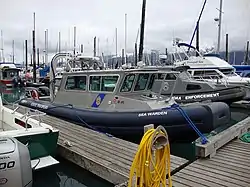
The Alaska State Troopers operate the following vehicles:
- Chevy Express Van
 United States
United States - Chevrolet Impala
 United States
United States - Chevy pickup truck
 United States
United States - Dodge Charger
 United States
United States - Ford Crown Victoria Police Interceptor
 United States
United States - Ford Police Interceptor Sedan
 United States
United States - Ford Police Interceptor Utility
 United States
United States - Ford Expedition
 United States
United States - Ford F-250
 United States
United States - Ford F-150
 United States
United States - Lenco BearCat
 United States – 3[21]
United States – 3[21]
Aircraft
- Beechcraft Super King Air
 United States
United States - Cessna 185
 United States
United States - Cessna 208
 United States
United States - Eurocopter AS350
 France
France - Piper PA-18
 United States – used for fisheries patrol
United States – used for fisheries patrol - Robinson R44
 United States
United States
Previously-issued sidearms
- Smith & Wesson Model 4006 .40 S&W- replaced by the Glock Model 22 .40 S&W
- Smith & Wesson Model 686 .357 magnum- replaced by the Smith & Wesson Model 4006
- Smith & Wesson Model 66 .357 magnum- replaced by the Smith & Wesson Model 686
- Smith & Wesson Model 19 .357 magnum- replaced by the Smith & Wesson Model 66
Museum
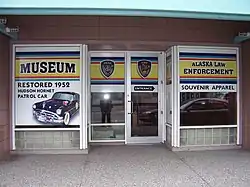
The Alaska Law Enforcement Museum is a small museum located at 245 W. 5th Avenue, Suite 113 across from the 5th Avenue Mall in downtown Anchorage, operated by the Fraternal Order of Alaska State Troopers. The museum commemorates the Alaska State Troopers and features a variety of historical memorabilia, including a restored 1952 Hudson Hornet patrol car.
In popular culture
Clint Walker starred as the title character in Kodiak, a short-lived TV series that ran on ABC in 1974. Walker played "Kodiak" McKay, an officer in what was called, in this series, the "Alaska State Patrol."
The National Geographic hit television reality series Alaska State Troopers accompanies troopers throughout the state as they perform their various duties. The show depicts firsthand, the short-handed troopers in their harsh and dangerous duties of the AST. Two troopers who regularly appeared on the show, Sergeant Patrick "Scott" Johnson and Trooper Gabriel Rich were both shot and murdered in the line of duty, while investigating a weapons complaint in the small rural Arctic town of Tanana (Yukon River) in 2014. The show has been very positively received worldwide and is credited with a peak in interest by people wanting to serve as an Alaska Trooper or other peace officer in Alaska.
Alaska State Troopers appear prominently and regularly on other TV reality shows such as Ice Road Truckers, Tougher in Alaska and Deadliest Catch. They were also featured occasionally on the show Northern Exposure as the Alaska State Police.
Alaska State Troopers were highly visible during the 2008 Presidential campaign, providing security detail supplemental personnel to the US Secret Service while protecting former Alaska Governor and Republican Vice presidential candidate Sarah Palin.
See also
- Alaska State Troopers (TV series)
- Alaska Public Safety Commissioner dismissal
- Highway patrol
- Jean Frances Howard, who was AST's first female sworn officer and was inducted into the Alaska Women's Hall of Fame by virtue of that accomplishment of being a State Trooper
- List of law enforcement agencies in Alaska
- State Patrol
- State police (United States)
References
- "Alaska Population Estimates".
- "AST History".
- "Alaska State Troopers|Bureau of Highway Patrol". dps.alaska.gov. Retrieved 2021-09-06.
- "Alaska Bureau of Investigation". dps.alaska.gov. Retrieved 2021-09-06.
- "Alaska State Troopers|Special Emergency Reaction Team (SERT)". dps.alaska.gov. Retrieved 2021-09-06.
- "Statewide Drug Enforcement Unit". dps.alaska.gov. Retrieved 2021-09-06.
- "2018 Alaska Statutes :: Title 18. Health, Safety, Housing, Human Rights, and Public Defender :: Chapter 60. Safety :: Article 2. Search and Rescue. :: Sec. 18.60.120. Search and rescue parties". Justia Law. Retrieved 2021-09-06.
- "Search And Rescue". dps.alaska.gov. Retrieved 2021-09-06.
- "Alaska Mountain Rescue Group". amrg.org. Retrieved 2021-09-06.
- "Alaska State Troopers|A Detachment North". dps.alaska.gov. Retrieved 2021-09-06.
- "Alaska State Troopers|B Detachment". dps.alaska.gov. Retrieved 2021-09-06.
- "Alaska State Troopers|C Detachment". dps.alaska.gov. Retrieved 2021-09-06.
- "Alaska State Troopers|D Detachment". dps.alaska.gov. Retrieved 2021-09-06.
- "Alaska State Troopers|Dispatch Services". dps.alaska.gov. Retrieved 2021-09-06.
- "Soldotna Dispatch". www.911kenaipeninsula.com. Retrieved 2021-09-06.
- "Alaska State Troopers|Public Safety Training Academy". dps.alaska.gov. Retrieved 2021-09-06.
- "Standards - Academy - Comm - Alaska Department of Public Safety".
- "Alaska State Troopers|Public Safety Training Academy (Expectations)". dps.alaska.gov. Retrieved 2021-09-06.
- "Home – VPSO – AST – Alaska Department of Public Safety". dps.alaska.gov.
- "Alaska State Troopers, AK".
- Alaska State Troopers purchase three Lenco BearCats – Armyrecognition.com, March 22, 2013